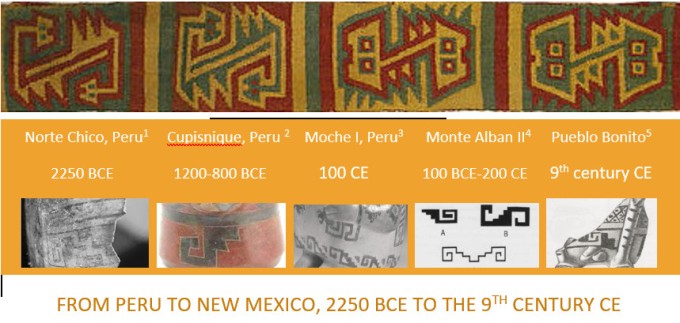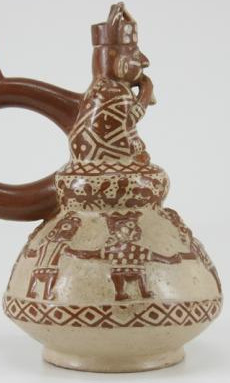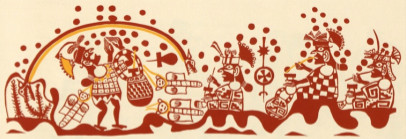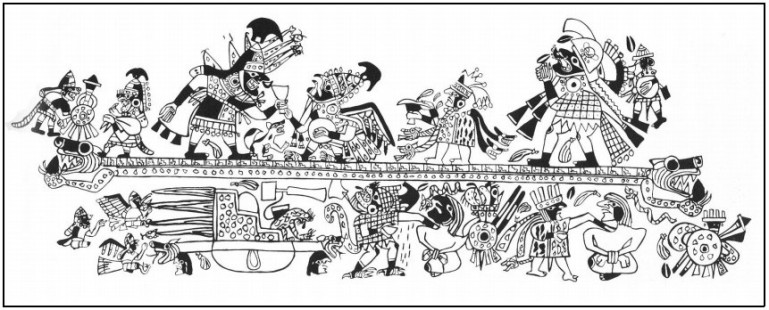
In the social context of visual programs of Twisted Gourd symbolism, we have in addition hieroglyphic narratives for the Maya divine kings and ethnographic narratives for the (Anasazi) ancestral Puebloan god-like ruler (Tiamunyi/Tsamaiya Warrior) that indicate a celestial House of the North, the Milky Way river of life, and a terrestrial “place of mist” (the cosmic navel and centerplace of the axis mundi) were cosmological constructs involved in establishing ancestor veneration that legitimated the rule of a dynastic lineage. For the Moche, also in the context of Twisted Gourd symbolism, we have their visual program of thousands of images on ceramics and monuments that showed their tutelary deity, Aia Paec (“Maker-Doer”), as the ancestral snake-jaguar Mountain/cave lord that wore the Milky Way as his belt and held it up over his head. From those images, supported by evidence from the Maya and Puebloans, it was possible to work out the fact that the Twisted Gourd symbol was an ancestral Snake-Mountain/cave-Cloud/lightning narrative that represented the “place of mist” from which life emerged. That was the centerplace of the cosmos around which all life was directionally ordered by the movement of the sun (light, fire, heat, e.g., “radiance”) and Milky Way (water, cloud, lightning). Moche art makes it clear, especially in the coca-chewing ceremonies, that, like the Maya and Puebloans, the divine attributes of Aia Paec that were passed to his descendants, the Moche, also included radiance, lightning, and the creative capacity of the “misty” state of the Makers.
All of the images below refer to the Moche coca chewing ceremony, except for the famous Presentation/Sacrifice Theme that linked Moche art with archaeology and a similar scene of sacrifice that provides a bigger picture of the actual pageantry that was associated with keeping the world in balance. It is helpful to remember that these symbols were part of a powerful visual program and its intent was to shape a cooperative community of thought by constantly reiterating an ideology that explained the way things were, where authority was vested, and why. The coca ceremony has been verified through archaeological artifacts associated with rulership to represent ritual warfare and blood sacrifice. Both coca ceremony and the sacrifice/presentation theme have been shown below to be a unified symbolic complex signified by the shared Twisted Gourd symbol.
The Priests

ML001059. This coca-chewing image is important because it reveals more of the signs that were integrated with the Serpent-Mountain/cave-Cloud narrative of Twisted Gourd symbolism. Here we see the dot-in-circle symbol around the cloud-mountain stepped triangles; the curvilinear scroll of the bicephalic serpent on his thigh and the bicephalic serpent as a rectilinear scroll on the bottom of his tunic, which I believe are female (“Below”) and male (“Above”) forms of the stepped fret from the Twisted Gourd symbol, respectively.

ML001062, Twisted Gourd symbolism identified members of the royal family who were related to the venerated ancestors. This important enthroned personage who chews coca (pouch in cheek) is drawn to look like Aia Paec, a Moche founding ancestor whose spirit dwells in and transforms all forms of life, but especially his descendants. It tells us that some of the high-ranking shamans who wore the two-hand headdress and quadripartite checkerboard emblems were prophetic sky watchers. His transcendent position above the stepped triangles (ancestral mountain, throne) infers his attention is directed to the sky during his altered mental “cloud” or misty state as he communes with the ancestors. The stepped mountain under his seat has within it a triangle (cave) containing a tinkuy (bicephalic serpent), and his throne has rain drops in bands running down the sides, which infer his task may have been to discern astronomical signs that allowed rain rituals to be scheduled. The truncheon on the back of his head functionally may have suggested that he was also a warrior priest or a diviner that accompanied troops, but it was first a visual convention that said this high priest had legitimate power to enforce his authority because of his ancestral connections with Aia Paec.
 ML004112 detail. An Aia Paec impersonator from the Moche royal family is shown participating in a coca ceremony with two other shamans. He wears his solar headdress with a serpent scroll and a metal-plated tunic with the dot-in-square symbol, a pattern associated with authority and the Moche royal family’s ancestral feline effigy that hangs from his back. The visual resemblance between these high ranking priests and the way Aia Paec is represented in the visual program confirms continuity of the overarching idea of “transformation” that Jones (2010) described for the Cupisnique/Chavin horizon 1,000 years earlier, that is, Aia Paec as a mountain god with his feline powers and pet bicephalic serpent is the one incarnated during the transformed “misty” state by ritual specialists like these who wear his emblems.
ML004112 detail. An Aia Paec impersonator from the Moche royal family is shown participating in a coca ceremony with two other shamans. He wears his solar headdress with a serpent scroll and a metal-plated tunic with the dot-in-square symbol, a pattern associated with authority and the Moche royal family’s ancestral feline effigy that hangs from his back. The visual resemblance between these high ranking priests and the way Aia Paec is represented in the visual program confirms continuity of the overarching idea of “transformation” that Jones (2010) described for the Cupisnique/Chavin horizon 1,000 years earlier, that is, Aia Paec as a mountain god with his feline powers and pet bicephalic serpent is the one incarnated during the transformed “misty” state by ritual specialists like these who wear his emblems.

ML010850– No fangs are apparent, just feline face paint, and so this is still a high ranking member of the royal family whose authority is validated by his descent from Aia Paec. As an Aia Paec impersonator he is shown wearing the divinized Twisted Gourd symbol that Aia Paec owns, receiving tribute, and holding the cup of sacrifice. As a personification of Aia Paec, he oversees two shamans, one wearing the tinkuy, participating in a coca chewing rite under the Milky Way arch of the bicephalic serpent. Between them is a standard holding the dot-in-circle symbol, which associated blood and water, the serpent, and the pelagic markings of a puma (see theCirculatory Nature of the Cupisnique/Moche World). The stream of material coming from his nose is a common visual metaphor for the nasal, eye, and mouth discharges that are associated with inhaling or ingesting mind-altering plants. These are considered sacred substances that are ritually like-in-kind with rain.

ML012778 This image tells us a great deal about the Moche’s cosmovision that was encoded in Twisted Gourd symbolism. This Aia Paec impersonator from the Moche royal family wears the two-hand headdress and a “tinkuy” cloak (Twisted Gourd symbol is co-identified with the tinkuy), and so his role lies at the very center of Andean water-world cosmology that is integrally linked to the royal family. He plays the flute, and his venerated ancestors dance to his tune in the lower world. There is a line of dry sand and cactus between the earth and underworld, which suggests the dry season and he may be calling for rain. His ancestors all wear high-status headdresses and one wears the checkerboard tunic, and so he is from a long line of priests that held office at the highest echelon of Moche social organization. The dot-in-diamond pattern beneath the ancestors is the Milky Way/bicephalic serpent as it passes through the underworld.

ML002229. This anthropomorphic drum shows in-curved Twisted Gourds, which refer to the primordial ocean and regenerative cycle of life through blood sacrifice (see the tomb of the Lady of Cao where this symbol is prominent). As the marine Strombus : Spondylus dyad was an index for the primordial origin of life and gendered world (Jones, 2010), terrestrial snails affixed to ceremonial items referred to fertility and the water cycle as a harbinger of spring: they still come out from underneath San Pedro cactus when there is enough moisture for them to breed, and thus they signal the onset of the rainy season at the December solstice after a long, dry spell. This integration of the natural environment with the ideology of the Twisted Gourd symbol set is the basis for the Andean ecocosmovision.

ML001064– An Aia Paec impersonator participating in coca chewing. This image provides a clear look at the feline face paint worn by Aia Paec impersonators. He wears the quadripartite checkerboard tunic, the double-serpent scroll (bicephalic serpent) as a hem, and the two-hand feline headdress. The cardinal and intercardinal directions inferred by a quadripartite symbol meet at a centerpoint that is animated by ritual, and this tunic is associated with the Presentation/Sacrifice theme shown below. The penultimate moment of ritual is when Aia Paec lifts the ceremonial cup of blood in offering and then drinks it, which is an offering of sami to the Moche community. This actor’s symbol set may inform that process. It is divided into upper, middle and lower sectors, where the middle quadripartite symbol is framed by feline (mountain-cave) and serpent (chthonic) connection symbols, which suggest communion with an ancestor and sacrificial blood. The significance of the two-hand headdress, which can appear as feline paws, feathered tufts, or human hands, isn’t known, but an important preceramic religious tradition that preceded this ceramic representation–the Kotosh, followed by the YaYaMaMa– also featured two hands.
 ML001475. Aia Paec himself as Moche culture hero and progenitor as the spiritual essence of a Strombus, from the myth cycle. The important role the Strombus trumpet played in ritual as an index of the primordial ocean and origin of life that pointed back to Caral and the Cupisnique/Chavin horizon brings Moche origins together with the present generation of a royal family. Many Amerindian origin stories tell of emergence onto the surface of the earth through a cave or body of water. The call of the Strombus trumpet to summon a divinized ancestor like Aia Paec in the context of the Milky Way water cycle running through the triadic world reveal how that was possible.
ML001475. Aia Paec himself as Moche culture hero and progenitor as the spiritual essence of a Strombus, from the myth cycle. The important role the Strombus trumpet played in ritual as an index of the primordial ocean and origin of life that pointed back to Caral and the Cupisnique/Chavin horizon brings Moche origins together with the present generation of a royal family. Many Amerindian origin stories tell of emergence onto the surface of the earth through a cave or body of water. The call of the Strombus trumpet to summon a divinized ancestor like Aia Paec in the context of the Milky Way water cycle running through the triadic world reveal how that was possible.
The Ceremonies:

Coca Ceremony, Maltese Cross, and tinkuy on the chest of the center living-dead ancestor, one of the Priests of the Bicephalic Arch and the Milky Way. This scene, contextualized as “ancestor veneration” by the Twisted Gourd symbolism, is divided into the liminal or “otherworld” misty space of the three living-dead ancestors sitting on the right and a high-status ritualist who enters the misty state to communicate with them on the left. The three “Priests of the Bicephalic Arch”–the Milky Way– are represented by the feline effigies attached to the ritualist, which clearly indicates that the Milky Way river of life and the trinity of animal lords were intimately connected with the divinized ancestors that validated a dynastic lineage and legitimated their heirs. The Maltese or quadripartite cross that is co-located with them is the pan-Amerindian sign for the cosmic Serpent. Its presence, which signifies a cosmic Centerplace and its occupant, strongly suggests that the Moche, like the Maya and Puebloans, venerated the cosmic Serpent (amaru, Plumed Serpent) and regarded it as the father of their founding ancestor, Aia Paec, and grandfather of his descendants.

The tinkuy on the chest of the central actor confirms that this coca ceremony is a process of crossing a threshold and ritually incarnating an ancestral nature power, as signified by the multiple images of the Moche royal family’s feline effigy on the left. The fact that there are three feline effigies on the left and three shamans on the right all wearing the solar headdress suggests that they may be the ancestors who once wore the feline effigies. The yellow (solar) highlight given to the lime stick on the right, the ropes on the ancestral effigies, the solar headdress, necklace, the lime stick in the coca bag on the left, and especially the Milky Way arch associate the coca ceremony with ancestor worship and the sun-water cycle, probably on a solstice: the Maltese Cross standard is in the form of the celestial X created by the ecliptic and the Milky Way when they cross paths at the solstices. The ropes refer to the serpent, and this entire scene appears to be taking place on a bilayer of clouds that suggests dark-cloud constellations. Taken together the sun-water cycle association in this scene with the San Pedro cactus on the left suggests the December solstice, when the solar standstill and the end of the dry season coincide and anticipate the arrival of the rain serpent. This scene again confirms that Aia Paec was the founding ancestor and culture hero to the Moche family that represented their lineage with the feline effigy and Twisted Gourd symbol set.

Coca Chewing Ceremony: The Priests of the Bicephalic Arch, the Milky Way. Source of line art, McLelland, 1975; Donnan, 1978
ML004112, Coca Ceremony. The plant life and pile of tribute suggest that this scene is a different time of year from the previous scene. The light band on this Milky Way arch is the reverse of the scene above and has noticeable solar rays, which are characteristic of the Dragon form of the bicephalic serpent. Note the feline effigy hanging from the back of the Aia Paec impersonator and what appears to be another feline effigy on the pile of tribute. The dot-in-diamond symbol on the coca bag and the serpent scroll in the solar headdress refer to the water serpent. Depending on elevation and region the harvest season in Peru extends from March to August, therefore this could be a March rite at the equinox or, as reported by Green and Green (2010), a rite celebrating one of the five annual rains. The possible correlation of the serrated Dragon with the crossing of the Milky Way and ecliptic at the solstices remains to be worked out to account for the solar symbols. Obviously these scenes have several calendrical associations that remain to be worked out and would provide insight into the ritual roles of these elite family members.


Presentation/Sacrifice Theme (McClelland, 1975; Donnan and McClelland, 1999). Notice the Aia Paec impersonator in the quadripartite checkerboard pattern accepting the cup of sacrifice and the actors that wear the dot-in-square pattern of his ancestral family lineage. The bicephalic serpent divides this drama into upper and lower registers, where the upper register was a public performance during which the main actor on the left assumed Aia Paec’s identity to accept the blood sacrifice. The lower register was in the underworld. Represented is the transcendent state of female priests as they made the sacrifices and collected the blood. The priestess in the middle appears to have entered the feline nahual state and wears the dot-in-square pattern of the Moche royal family. Although there are a number of male signs associated with this actor, they do not preclude the possibility that it is a female. Jeffrey Quilter noted, for example, that the Lady of Cao “had been made male” in death through the inclusion of ceremonial weapons in her grave. It may be that females with authority were likewise made male for key ceremonies. The two actors on the right in the top register have been identified as historical priestesses, one of them the office the Lady of Cao held. This suggests that the Sacrifice Theme was gendered, with female priestesses sacrificing the prisoners and spilling their blood to nourish the earth while supplying the replenishing drink of life (blood) to Aia Paec in the upper terrestrial register.

Scene of sacrifice (Hill, 2006:fig.5 after Kutscher, 1983:fig.123). In this image we continue to notice the appearance of two important actors. An enshrined Aia Paec ancestor on the left (cup of blood, roof as checkerboard symbol:Milky Way) sits in a huaca atop a stepped pyramid (mountain) where the Milky Way is held up by the serpent that is also present in the lower register (underworld). The head form of the serpent has been interpreted as a feline (ML curators) or fox because of the way the heads are drawn on the animals on top of the huaca (Uceda, 2008), although the fox is generally drawn with a full tail. I believe based on the way the teeth and long, laid back ears of the serpent are drawn in the lower register that a deer is also inferred to point out the predator : prey theme that Jones (2010) identified in Cupisnique art and upon which Moche art was based. [Compare the deer head on Kerr vase K2023 for example.]
Notice that just as the checkerboard is represented from a sideview as a bar of black and white rectangles, so does the floating object in the center represent the dot-in-square pattern associated with the royal family’s feline effigy. The Owl Decapitator at the huaca topped by war clubs in the middle of the upper register serves a member of the elite family, who also holds the cup and wears the ancestral feline emblem and the dot-in-square symbolic clothing. The dot-in-square symbol on elite clothing was made from shiny metal plates, which infer a tinkuy as light strikes the symbol for the bicephalic serpent (water), thereby showing the leader as a centerplace and source of the vital essence.
There is an element of triumphalism in the scene as we watch the companions of a defeated warrior carry him in a litter (defeat of a high status individual). After he runs up the “mountain” huaca we see him next being processed–bled and decapitated– in the lower register. The females dressed in black look like carrion-eating birds (ML001475) and are probably specialized ceremonial “staff” [lower ranking priests dressed as females or actual female priests] to the royal family on the day of sacrifice, where it appears that at least three incarnated deities are being fed and revitalized from one sacrificial victim. Their role reiterates the idea that females dismembered bodies and in other ways returned to the earth the fruits of sacrifice. This gives us some insight into the role of the Lady of Cao as a female ruler/officeholder. The association of the condor, a scavenger, with the scavenging black birds in Moche art (ML013344) that play a vital role in the life-death-regeneration process also reveals the continuity of the role played by the archetypal condor of the triadic realm, first seen 2500-3000 years earlier at Huaca Prieta and Chavin de Huantar).
Twisted Gourd Symbol Set Context:
The intimate association between the nature powers and processes, social elites, and the Twisted Gourd symbol with the coca chewing ceremony strongly suggests it was a seasonal rain rite possibly connected to the intersection of the Milky Way with the ecliptic, which would have been celebrated at the December (wet) and June (dry) solstices. Evidence for solstitial celebration is the fact that the snail (shown below), a good food source, was associated with coca chewing and is a harbinger of the onset of rain after the December solstice. At any rate it was an occasion for blood sacrifice, and the iconography shown here reflects archaeological findings (Uceda, 2008).
See Checkerboard: the Bicephalic Serpent as the Milky Way

This work is under a Creative Commons Attribution-Noncommercial-NoDerivatives 3.0 Unported license . Suggested citation for text: Devereaux, M.K., 2018. Twisted Gourd, The Symbolic Language of the Precolumbian Rainmakers, http://www.thetinkuy.wordpress.com.






















